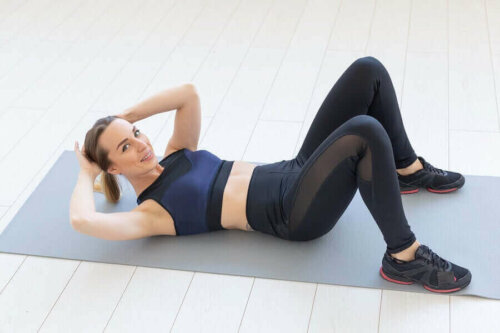Five Exercises to Strengthen Your Spine


Reviewed and approved by the doctor Maricela Jiménez López
To strengthen your spine, you should dedicate some time to exercising. Although many people choose to lead sedentary lifestyles, exercising regularly strengthens the muscles of this area and also reduces the risk of problems such as herniated discs or sciatica.
On the other hand, it helps improve your body posture, often a factor that leads to back pain, as stated in a study published by Scoliosis and Spinal Disorders. In the long run, exercising reduces the risk of chronic diseases such as arthritis. So, do you want to learn more? Below, learn about five great exercises to strengthen your spine.
How to strengthen your spine
When practicing exercises to strengthen your spine, you must first consider your physical ability, age, and health condition. If you suffer from a condition or specific injury, it’s best to consult a professional to determine whether you should do these exercises.
If the professional green lights you to do them, you should know that you’ll only benefit from these exercises if you do them regularly. It’s useless to do them a couple of times a week and then return to a sedentary lifestyle. Make them part of your routine!
1. General back stretch

This exercise helps stretch your back muscles and promotes relaxation through breathing.
General back stretching is a simple, low-impact exercise to strengthen your spine and reduce the recurrence of back pain. In fact, as detailed in a study published in the Boletín de la Asociación Médica de Puerto Rico, stretching is the basis of rehabilitation for this problem.
- First of all, lie on your back on an exercise mat
- Then, bend your legs and bring both knees to your chest, with the help of your hands
- After that, breathe through your nose and release it through your mouth
- Return to the starting position and do 15 repetitions
Read and Find Out How to Stretch Your Spine in Just Two Minutes
2. Lying oblique crunch
This simple exercise has many benefits. It strengthens your lower back and decreases physical pain. In addition, it strengthens your obliques.
Precisely this work of the middle zone is very good for relieving lower back pain. This is ratified by scientific studies, as is the case of a study published by the Journal of Back and Musculoskeletal Rehabilitation.
- First, lie on your back on the mat with your legs bent
- Then, bring your knees to the right and left, alternating either side
- Be sure to keep your shoulders and both feet on the mat
- While doing the movement, breathe through your nose and release the breath through your mouth
- Do between 12 and 15 repetitions per side
3. Strengthen your spine with a posterior stretch
The posterior stretch is a good complement when your goal is to strengthen your spine. Not only does it exercise the muscles, but it decreases the tension that usually affects the lower back, according to research published in Spine magazine.
If you want, you can use a resistance band to make it easier. You have to place it on the foot you’ll be lifting and hold it with both hands.
- First, lie on your back on the mat with your legs bent
- Then, take a breath through your nose and stretch one leg
- After that, exhale through your mouth while you raise the leg you had previously bent. Raise it toward the ceiling, keeping your knee fully straight.
- Hold the posture for five seconds and lower slowly
- Do 10 to 12 repetitions with each leg
4. Upper abs

The advantage of exercises to strengthen your spine is that they’re also useful for working out other muscle groups. In this case, we propose you do upper ab exercises that let you exercise your abdomen and back at the same time.
- Maintaining the basic position (lying face-up on the mat), put your hands behind your head or crossed over your shoulders
- Then, take your chest and shoulders toward your knees. Be sure to keep a neutral position.
- Hold for three seconds and return to the starting position
- Do between 12 to 15 repetitions
5. Contralateral leg and arm lift

In addition to strengthening your spine, this exercise is perfect for coordination. You can do it lying face down or on all fours. If you don’t have enough strength, it’s best to start with the first option.
- Lie face down, with your legs fully stretched on the mat and a pillow under your abdomen
- Then, raise an arm and leg on the opposite side, without lifting your body from the mat
- Hold the position for three to five seconds and go back to the initial position
- Then, do the same exercise but with the other arm and leg
- Do 12 to 15 repetitions
If you choose to do it on all fours, get on all fours and repeat. However, be sure that your raised arm and leg are properly aligned with your back.
Final tips to strengthen your spine
Exercises to strengthen your spine can be very beneficial if you do them correctly. If you have questions about any position, consult a professional trainer. Keep in mind that not doing the above exercises correctly can have negative consequences.
On the other hand, if you want to maintain a healthy spine, you should supplement these exercises with other healthy habits. Thus, be sure to apply the following in your daily routine:
- Eating healthy foods rich in omega-3 fatty acids, antioxidants, proteins, vitamins, and minerals. In general terms, a diet that modulates inflammation should be planned, since this could have an impact on chronic lumbar pathologies, according to a study published by International Musculoskeletal Medicine.
- Correct your body posture, both when walking and when you’re seated
- Do breathing exercises that contribute to muscle relaxation and stress reduction, according to a WebMD article
- Avoid physical overexertion, especially if you’re not in a good physical condition
- Get a good night’s sleep since rest problems are closely linked to the onset of chronic back pain, according to a study published by The Clinical Journal of Pain
Consult your doctor first
Do you have a back condition? Do you have recurring back pain? Then you should do all these exercises and you’ll probably start to feel better in a short time.
However, consult your doctor to determine how to treat it if your symptoms don’t go away or are due to another condition. In many cases, prompt treatment helps to relieve discomfort quickly and prevents further progression of the problem.
All cited sources were thoroughly reviewed by our team to ensure their quality, reliability, currency, and validity. The bibliography of this article was considered reliable and of academic or scientific accuracy.
- Kumar, T., Kumar, S., Nezamuddin, M., & Sharma, V. P. (2015). Efficacy of core muscle strengthening exercise in chronic low back pain patients. Journal of Back and Musculoskeletal Rehabilitation. https://doi.org/10.3233/BMR-140572
- Baerga-Varela, L., Abreu Ramos, A. M., & Abréu Ramos, A. M. (2006). Core strengthening exercises for low back pain. Bol Asoc Med P R. https://pubmed.ncbi.nlm.nih.gov/19610550/
- Caufriez, M., Fernandez, J. C., Fanzel, R., & Snoeck, T. (2006). Effects of a program of constructed training in Hipopressive Gymnastic on the vertebral cervical and dorsolumbar statics. Fisioterapia. https://www.elsevier.es/pt-revista-fisioterapia-146-articulo-efectos-un-programa-entrenamiento-estructurado-13092643
- Rainville, J., Hartigan, C., Martinez, E., Limke, J., Jouve, C., & Finno, M. (2004). Exercise as a treatment for chronic low back pain. Spine Journal. https://doi.org/10.1016/S1529-9430(03)00174-8
- van Middelkoop, M., Rubinstein, S. M., Verhagen, A. P., Ostelo, R. W., Koes, B. W., & van Tulder, M. W. (2010). Exercise therapy for chronic nonspecific low-back pain. Best Practice and Research: Clinical Rheumatology. https://doi.org/10.1016/j.berh.2010.01.002
- Kelly, Gráinne A.; Blake, Catherine; Power, Camillus K.; O’Keeffe, Declan; Fullen, Brona M. 2011. The Association Between Chronic Low Back Pain and Sleep: A Systematic Review. The Clinical Journal of Pain – Volume 27 – Issue 2 – p 169-181
doi: 10.1097/AJP.0b013e3181f3bdd5 - Breathing Techniques for Stress Relief. WebMD. https://www.webmd.com/balance/stress-management/stress-relief-breathing-techniques#1
- Kieran Macphail. (2015). C-reactive protein, chronic low back pain and, diet and lifestyle. International Musculoskeletal Medicine, 37:1, 29-32, DOI: 10.1179/1753615415Y.0000000001
- Khalil TM, Asfour SS, Martinez LM, et al. 1992. Stretching in the rehabilitation of low-back pain patients. Spine. DOI: 10.1097/00007632-199203000-00012.
- Wong, A. Y., Karppinen, J., & Samartzis, D. (2017). Low back pain in older adults: risk factors, management options and future directions. Scoliosis and spinal disorders, 12, 14. https://doi.org/10.1186/s13013-017-0121-3
This text is provided for informational purposes only and does not replace consultation with a professional. If in doubt, consult your specialist.








